This specimen isn't in Hong Kong though, but rather the Quail Botanical Gardens in San Diego.
Sunday, June 28, 2009
Hong Kong Orchid Tree
This specimen isn't in Hong Kong though, but rather the Quail Botanical Gardens in San Diego.
Wednesday, June 24, 2009
Latest game cam

We haven't had a bobcat picture in quite a while. This one seems particularly well-fed.

He probably ate all our chickens, but he sure is handsome.

Tentative fawn. Click to see the larger version... you can still see some spots on the haunch.

The fawn in the foreground is too dark and the deer in the background is too light, but I thought the focus was reasonably good on both of them.
It's gotten warm again lately, which means the animals have to be closer to the camera to trigger it. The weatherman was expecting a high of 75° yesterday, but I'm not sure it reached that here. (That would be a record high.)
New film downloads in the shop
I have just added HD downloads of the Hot Aches Productions films to the shop. So now you have a cheaper and more instantaneous way to watch the classic climbing films: The Long Hope, The Pinnacle, Committed 1, Committed 2, Wideboyz, Odyssey and Monkey See Monkey Do. You’ll find them all here.
The DVD options are still there too of course...
Monday, June 22, 2009
'Tis Nevermore :: The Nevada Shoe Tree is Gone
In the high desert of Nevada, a large Cottonwood Tree stood for decades alongside a stretch of U.S. 50 near Middlegate, between Fallon and Ely. Known as The Loneliest Highway in America, it is now even more lonely because a local icon has been destroyed.
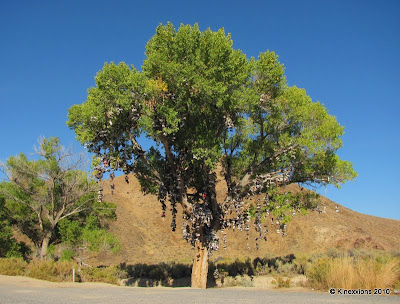
The Shoe Tree was introduced to you, my readers, in Redefining Shoe Tree. About a week ago I was contacted by a gentleman who wrote a song about the tree being cut down. He wanted to use the photographs from my blog post in a video tribute to the tree. I was truly saddened to hear of the demise of the Shoe Tree.
A Google Search turned up numerous articles about the old tree telling what is known of the incident and a little history of the tree.
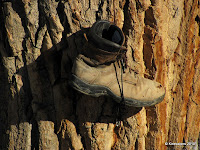 A month ago, vandals pulled out their chain saw and cut the Shoe Tree down. No one except the culprits saw the deed being done. As it so happens, the Shoe Tree was on property owned by the Bureau of Land Management so if the culprits are ever found, they will face federal charges. The incident is still under investigation.
A month ago, vandals pulled out their chain saw and cut the Shoe Tree down. No one except the culprits saw the deed being done. As it so happens, the Shoe Tree was on property owned by the Bureau of Land Management so if the culprits are ever found, they will face federal charges. The incident is still under investigation.
There is no understanding acts of vandalism. Nothing will bring the old tree back, but I hope that the culprits are caught and get the punishment they deserve!
The music video tribute by Chris “CW” Bayer has been posted on You Tube: Someone Cut the Shoe Tree Down.
Disclaimer: I have no business or other relationship to or with Chris Bayer. I received no remuneration from him for his use of my photographs. The video is simply a tribute to an icon and will not be for sale.

The Shoe Tree was introduced to you, my readers, in Redefining Shoe Tree. About a week ago I was contacted by a gentleman who wrote a song about the tree being cut down. He wanted to use the photographs from my blog post in a video tribute to the tree. I was truly saddened to hear of the demise of the Shoe Tree.
A Google Search turned up numerous articles about the old tree telling what is known of the incident and a little history of the tree.
 A month ago, vandals pulled out their chain saw and cut the Shoe Tree down. No one except the culprits saw the deed being done. As it so happens, the Shoe Tree was on property owned by the Bureau of Land Management so if the culprits are ever found, they will face federal charges. The incident is still under investigation.
A month ago, vandals pulled out their chain saw and cut the Shoe Tree down. No one except the culprits saw the deed being done. As it so happens, the Shoe Tree was on property owned by the Bureau of Land Management so if the culprits are ever found, they will face federal charges. The incident is still under investigation.There is no understanding acts of vandalism. Nothing will bring the old tree back, but I hope that the culprits are caught and get the punishment they deserve!
The music video tribute by Chris “CW” Bayer has been posted on You Tube: Someone Cut the Shoe Tree Down.
Disclaimer: I have no business or other relationship to or with Chris Bayer. I received no remuneration from him for his use of my photographs. The video is simply a tribute to an icon and will not be for sale.
Sunday, June 21, 2009
New Baby

My neighbor came by today and said his mare finally had her baby. He is a beautiful baby. Same color as his mama. There is nothing cuter than a new born foal. (Unless it is a kitten) (or a puppy). Well, lets say I just love baby animals.
Myths About the Mixte
1. The mixte is a roadbike and a transportation bike in one
In theory yes, in practice not really. The typical mixte frame has roadbike geometry, combined with a lower step-over height than a diamond frame bike. The road geometry is what makes it light, fast, and suitable for being set up as a roadbike. The lower stepover is what makes mounting and dismounting easier, thus making it suitable for transportation.
But while the mixte frame design may work as a roadbike or a transportation bike, you can't actually set it up as both simultaneously. If you set up your mixte with upright handlebars, it will be faster than a heavy, upright city bike, but it will not perform like a roadbike with drop bars. On the other hand, if you set it up with drop bars it may perform like a roadbike, but the positioning will be too aggressive for a city bike. The mixte frame construction has the potential to be either, but you still have to choose.
That depends on where you are coming from. If you are used to diamond frame bicycles, then yes it is easier: On a mixte, you don't need to swing your leg around the back, but can lean the bike toward you and step over. However, if you are used to step-through and loop frame bicycles, the mixte may disappoint you. On step-through and loop frames, the top tube is low enough to just freely walk through. The mixte's stepover is considerably higher and requires leaning the bike toward you, then bending your leg at the knee in order to get your foot over. The construction also does not allow you to hop off the bike sideways as you're coming to a stop, as some get accustomed to doing on a step-through.
For comparison: The standover height on my Gazelle loop frame is 18.5", whereas the standover height on my Royal H. mixte is 24" - a substantial difference. Some find the mixte standover to be too high for the easy on-off they seek in a transportation bike.
Don't count on it. I've discussed this in an earlier post about buying a vintage mixte, but I still get lots of "I got this nice townie bike, but it's so uncomfortable!" emails, so I wanted to bring it up again. Mixte bicycles look cute and so we tend to assume they are easy to ride. But most of them are essentially roadbikes with upright handlebars, and road geometry does not make for the most relaxed and comfortable ride. Roadbike geometry also presents logistical problems, such as short chainstays making it more difficult to carry panniers, and toe overlap making tight turns trickier.
It is not impossible to find a comfortable mixte. If you're buying vintage, look for one that is a touring and not a road model, and is made of cro-moly steel. If you're buying new, I know that the Rivendell Betty Foy is a comfortable bike, and I've heard good things about the Soma Buena Vista's ride quality as well. And then of course there is the custom route, where the framebuilder can ensure that comfort is a priority. But there is nothing about the mixte design that is inherently comfortable; you will need to put some time into research and test rides.
Friday, June 19, 2009
Cold Ashby - Winwick - Cold Ashby (via Thornby Grange)
 |
| View on the way down Honey Hill |
We set off from the village hall, along Main Street, then took the right fork along Stanford Road, past the entrance to Cold Ashby Golf Club, and Bunkers Hill Farm. In a field there is a trig point marking a height of 210 metres. At the top of Stanford Road, on Honey Hill, you turn left along the small road past Honey Hill Farm, and along a narrow track beside trees, then across a field down to the golf course.
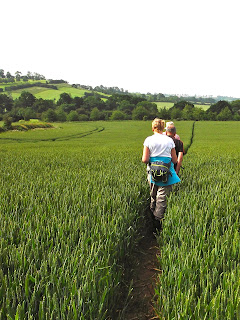 |
| The path is clear |
This part of the walk is part of the Jurassic Way - which I walked in reverse onMay 30 . There are excellent views, though today it was a little hazy.
On the other side of the golf course the path is clearly marked, along the edge of a couple of fields, then over some meadow, until you join a wider track, which leads to Winwick. A farmer was herding sheep using a dog and a car.

Before long you can see Winwick Hall ahead, and emerge on to the road. The brick wall and gateposts are curved.
 |
| Is Barry nostalgic for days on sentry duty? |
We had an early snack break by the pond, making use of the millennium seat constructed by students from Rugby School. A few drops of rain encouraged us to take waterproofs out, but stopped before we even put them on.

We walked down the hill past the black VR postbox, a door in the wall, and some well-tended flower potsto the crossroads, where we turned left along the gated road to West Haddon.
 |
| Red dog-rose or feral flower? |
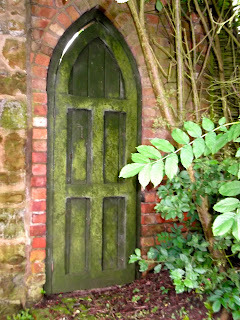 |
| a door in the wall |
After passing another Rugby School millennium seat of a different design, we turned left off the road, and followed a footpath, which becomes a track, and leads towards White House Farm. We joined the road for a short distance before taking a footpath/track to the right. This took us towards Grange Farm and Thornby Grange. Just before these buildings, in the valley there is another 'unsafe' building, which we learned is an abandoned watermill for flour. It was never used since someone was killed while the construction was being finished - though there may be more to the story.
 |
| The derelict mill |
As the weather was so sultry, we stopped for a second short break beside the road to Thornby Grange, then continued to a small crossroads. We took the left hand road towards Cold Ashby, ignoring the road into Thornby. This soon bent to the right and joined the Cold Ashby road from Thornby, and led us into Cold Ashby towards the church.
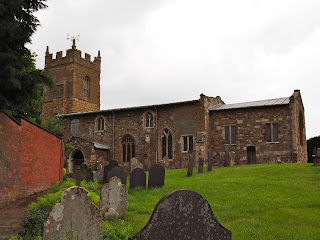 |
| St Denys Church, believed to date from the twelfth century - and the garden flowers are beautiful |
 |
| This stark reminder of mortality /immortality? was built in 1883, by "Gregorius Bateman' |
More info and pictures of the church are here. From the church we walked up to the road junction and turned left to our starting point.
Our thanks to The Cold Ashby Rambler for this walk
Thursday, June 18, 2009
Looking NorthEast
 From the Crest of the Sandias you can see Albuquerque but can look off to the northeast also.
From the Crest of the Sandias you can see Albuquerque but can look off to the northeast also.Wednesday, June 17, 2009
Tuesday, June 16, 2009
The Bicycle-Friendly Workplace
There is a range of opinions among cyclists about what constitutes a bicycle-friendly workplace. Some consider indoor bike parking a must. Others are concerned with shower facilities. Others still feel that bike to work schemes are crucial. More than anything, our ideas of a bike-friendly workplace seem to depend on how we construe transportation cycling.
For me personally, the most important thing about commuting is having a safe and comfortable route. As long as that is in place, I am pretty easy. At my last 9-5 job, the 4 mile riverside commute kept me happy. On arrival, I locked my bike to a pole. I brushed myself off in front of a mirror before facing co-workers.It did not occur to me to lament the lack of indoor bike parking, let alone to wish for showers at work.Once I transitioned to freelance and began to spend the day going from place to place, it made even less sense. "Hello, I'm here to meet about the XYZ project ...But first, do you have a shower I can use? I arrived by bicycle you see."
Others have different priorities, which is understandable. Long, strenuous commutes involve challenges that I do not usually face. Likewise with finding all-day bike parking in unsafe locations.
From an employer's perspective, the question is which priorities it makes the most sense to cater to. Is it the employer's responsibility to offer indoor parking? Many bicycle commuters say yes. Others feel it is the cyclist's responsibility to choose a bike that can be stored outdoors. What about shower facilities? There are those who lobby for them. And there are those who feel that the idea of showers at work conflates transport with sport.
Others believe that focusing on parking or showers is too narrow of an approach. What about calling for employers to open up shop in bike-friendly locations? What about travel compensation, tax incentives, bike share memberships, and the like? Or maybe a different paradigm altogether: What if neighbourhood employers join forces to sponsor bike lanes (and street plowing in winter) within an X mile radius?
Budgets are finite, and often employers get mixed messages as far as what cyclists are looking for. The bike-friendly workplace is a concept worth exploring more thoroughly.
Sunday, June 14, 2009
Piddington - Salcey Forest - Piddington
Led by Barry. With Gordon, Maureen and Eddie. Fine sunny morning. Just under 7 miles.
Piddington Roman Villa info
Upper Nene Archeological Society Piddington Dig Diaries
and finally . . . flapjack break.


 |
| Garden gnomes with a difference? |
 |
| Thatched shelter opposite a fallen tree under which, no doubt before it fell, we are told the sixth Duke of Grafton used to rest on his arduous way from his home to the church. |
 |
| Salcey Forest glow |
 |
| View from the high platform of the treetop walk. Northampton 'lighthouse' in the distance. |
 |
| Coffee and scone break |
 |
| Piddington Roman villa dig, with church in background |
Piddington Roman Villa info
Upper Nene Archeological Society Piddington Dig Diaries
 |
| Rarely heard words: 'Shall we hang on for Eddie?" |
 |
| Piddington Church |
and finally . . . flapjack break.



Saturday, June 13, 2009
The MacIntyre/Colton on the Grand Jorasses
And introducing Dave Searle as part of the Cold Thistle test team and the author of this guest blog piece. It is Dave's picture of Ally Swinton chugging up thesummit icefield of the Eiger that now graces the Cold Thistle masthead above. Welcome Dave!
“IT'S GOING TO BE A LONG NIGHT DUDE!”
....That’s the words Ally said to me when we topped out on Pointe Walker at 5.45pm after climbing the Colton/ McIntyre (with Alexis Crux Variation).
Our plan was to traverse the Jorasses, after climbing the north face, to the Canzio Hut at the Col des Grandes Jorasses for the first day of our epic link. We wanted to traverse the Rochefort Arete to the Forche hut and finish up the Cechinel Nominee on the Grande Pilier d’Angle to Mont Blanc.
Little did we know just how long the first day was going to be……
Be sure to dbl click the Dave's and Ally's photos to see any of them full size.
 Ally on the way up to the Leschaux hut.
Ally on the way up to the Leschaux hut.
We arrived at the Leschaux hut in good time on the Wednesday (21st) to hydrate, feed and sleep before our early start for the North face of the Grande Jorasses that night. Conditions looked good on the Colton/McIntyre, a lot better in fact than last time I was up there, but, looks can sometimes be deceiving.
 For those interested, Route marked with red on how to get to the bottom this year.
For those interested, Route marked with red on how to get to the bottom this year.
 Converse hut slippers= rad
Converse hut slippers= rad
Ally’s phone beeped into life at midnight signalling the time for the action to begin. We
brewed up, got ready and ate the mildly burnt porridge (nice one Ally) after what had turned out for me to be only a few hours of stressed out sleep.
We left the hut and were soon on our way up to the bottom of the face, navigating our way through the maze of crevasses up to the toe of the Walker Spur. One pitch of steep rotten ice got us over the first of three Bergshrunds with the next two being pretty straightforward to get us to the bottom of the face.
We moved together up the first ice field to the first ice crux. It was a lot steeper than the previous year when Myself, James and Gav had been on it. We were the first team up it too which meant every placement had to be swung for rather than hooked so it felt pretty hard, amplified by doing it by head torch.
I arrived at the bottom of the 2nd (real) crux to find it in less than ideal condition with a large blank section gaping the initial ice ramp and the steep wall.
 me leading up the first crux
me leading up the first crux
 ally at first light after the first icefield
ally at first light after the first icefield
We opted for the steeper and more technical Alexis variation (the same way that Mr. Steck went when he soloed the route in 2h25!!) due to the conditions. It was an impressive lead by young Ally, with hard to place gear, thin feet and lots of rotten ice to be cleared. A few American friends of ours have since been up on the face for the Colton/Mac and said they did do the original crux pitch but they also said it was quite hard too “I had to pull out all the tricks in the book for that one!”
 Ally on Alexis.
Ally on Alexis.
 Ally a bit further up Alexis.....
Ally a bit further up Alexis.....
 Me following Ally after Alexis
Me following Ally after Alexis
It took a little more time than we would have liked to climb this variation pitch but you can’t hurry these things. If it needs time it needs time. After this pitch we worked our way up to the bottom of the mixed pitches where I took over again. Thin ice, loose rock, poor gear was the order of the day but I knew what I was in for and the pitches aren’t that steep either, just delicate. Soon we were sunning ourselves on the walker spur on the way up to the summit. We passed the bit of tat that I had placed on a ledge, where we had bived the previous year, and I wave of relief washed over me knowing that I wasn’t going to have to sit another night out there without a sleeping bag!
 2nd mixed pitch.
2nd mixed pitch.
We topped out at 5.45pm giving a total of 13hours on the face. We briefly discussed our options as the original plan to traverse the to the Canzio Bivi hut that afternoon seemed like a lot of hard work. Quite an ambitious plan such as this can easily be spoilt but any number of factors and the lure of walking off the back for Italian Pizza’s was strong. We were both feeling the strain after the Colton/MacIntyre but decided we should at least give the traverse a go, so we set off shortly after topping out (Thursday) preparing ourselves for a long night….
 ooooohhh I think I need a sit down!
ooooohhh I think I need a sit down!
From Pointe walker to Pointe Croz is straightforward enough and it was soon after completing that section that it got dark….
 Sunset, just after Pointe Croz
Sunset, just after Pointe Croz
 Just before it got dark at the first 1st abb.
Just before it got dark at the first 1st abb.
The ridge is incredible, knife edge for the most part, with the 1000m north face on the right and equally long way down to Italy on the left. It was also incredibly loose in places which obviously takes a lot of care. There was a lot of rope on, rope off faffing about which eats the time up too. We must have taken the rope off for abs a total of 10 or so times. It was very cold too. We were both in all of our clothes and only movement was keeping us warm which stopped us from stopping to eat something warm. We made a fairly serious route finding error coming of Pointe Marguerite in our fatigued state. This cost us a huge amount of time, probably 4 hours in total. After we had corrected our error we eventually got to the top of Point Young the last summit on the traverse. From here it is about 200m of abseiling to get down to the col where the Canzio Bivi sits. We got down to the hut at 8.30am on Friday making it a 32hour single push from hut to hut. We were both seriously tired from such a long time on the go and with little food or rest (for me I had had ½ a pan of (slightly burnt) porridge, 4 chewy bars, 5 energy gels and a caffeine tablet that day).
As they say, "the rest of the story" is here:
http://searler.com//09/27/its-going-to-be-a-long-night-dude/
Enjoy!
Ally and Dave have been ripping it up this yearin the Alps. For Ally's version of the story and his comments on thenew RAB sponsorship (congrads Youth!) look here:
http://allyswinton.blogspot.com/
“IT'S GOING TO BE A LONG NIGHT DUDE!”
....That’s the words Ally said to me when we topped out on Pointe Walker at 5.45pm after climbing the Colton/ McIntyre (with Alexis Crux Variation).
Our plan was to traverse the Jorasses, after climbing the north face, to the Canzio Hut at the Col des Grandes Jorasses for the first day of our epic link. We wanted to traverse the Rochefort Arete to the Forche hut and finish up the Cechinel Nominee on the Grande Pilier d’Angle to Mont Blanc.
Little did we know just how long the first day was going to be……
Be sure to dbl click the Dave's and Ally's photos to see any of them full size.
 Ally on the way up to the Leschaux hut.
Ally on the way up to the Leschaux hut.We arrived at the Leschaux hut in good time on the Wednesday (21st) to hydrate, feed and sleep before our early start for the North face of the Grande Jorasses that night. Conditions looked good on the Colton/McIntyre, a lot better in fact than last time I was up there, but, looks can sometimes be deceiving.
 For those interested, Route marked with red on how to get to the bottom this year.
For those interested, Route marked with red on how to get to the bottom this year. Converse hut slippers= rad
Converse hut slippers= radAlly’s phone beeped into life at midnight signalling the time for the action to begin. We
brewed up, got ready and ate the mildly burnt porridge (nice one Ally) after what had turned out for me to be only a few hours of stressed out sleep.
We left the hut and were soon on our way up to the bottom of the face, navigating our way through the maze of crevasses up to the toe of the Walker Spur. One pitch of steep rotten ice got us over the first of three Bergshrunds with the next two being pretty straightforward to get us to the bottom of the face.
We moved together up the first ice field to the first ice crux. It was a lot steeper than the previous year when Myself, James and Gav had been on it. We were the first team up it too which meant every placement had to be swung for rather than hooked so it felt pretty hard, amplified by doing it by head torch.
I arrived at the bottom of the 2nd (real) crux to find it in less than ideal condition with a large blank section gaping the initial ice ramp and the steep wall.
 me leading up the first crux
me leading up the first crux ally at first light after the first icefield
ally at first light after the first icefieldWe opted for the steeper and more technical Alexis variation (the same way that Mr. Steck went when he soloed the route in 2h25!!) due to the conditions. It was an impressive lead by young Ally, with hard to place gear, thin feet and lots of rotten ice to be cleared. A few American friends of ours have since been up on the face for the Colton/Mac and said they did do the original crux pitch but they also said it was quite hard too “I had to pull out all the tricks in the book for that one!”
 Ally on Alexis.
Ally on Alexis. Ally a bit further up Alexis.....
Ally a bit further up Alexis..... Me following Ally after Alexis
Me following Ally after AlexisIt took a little more time than we would have liked to climb this variation pitch but you can’t hurry these things. If it needs time it needs time. After this pitch we worked our way up to the bottom of the mixed pitches where I took over again. Thin ice, loose rock, poor gear was the order of the day but I knew what I was in for and the pitches aren’t that steep either, just delicate. Soon we were sunning ourselves on the walker spur on the way up to the summit. We passed the bit of tat that I had placed on a ledge, where we had bived the previous year, and I wave of relief washed over me knowing that I wasn’t going to have to sit another night out there without a sleeping bag!
 2nd mixed pitch.
2nd mixed pitch.We topped out at 5.45pm giving a total of 13hours on the face. We briefly discussed our options as the original plan to traverse the to the Canzio Bivi hut that afternoon seemed like a lot of hard work. Quite an ambitious plan such as this can easily be spoilt but any number of factors and the lure of walking off the back for Italian Pizza’s was strong. We were both feeling the strain after the Colton/MacIntyre but decided we should at least give the traverse a go, so we set off shortly after topping out (Thursday) preparing ourselves for a long night….
 ooooohhh I think I need a sit down!
ooooohhh I think I need a sit down!From Pointe walker to Pointe Croz is straightforward enough and it was soon after completing that section that it got dark….
 Sunset, just after Pointe Croz
Sunset, just after Pointe Croz Just before it got dark at the first 1st abb.
Just before it got dark at the first 1st abb.The ridge is incredible, knife edge for the most part, with the 1000m north face on the right and equally long way down to Italy on the left. It was also incredibly loose in places which obviously takes a lot of care. There was a lot of rope on, rope off faffing about which eats the time up too. We must have taken the rope off for abs a total of 10 or so times. It was very cold too. We were both in all of our clothes and only movement was keeping us warm which stopped us from stopping to eat something warm. We made a fairly serious route finding error coming of Pointe Marguerite in our fatigued state. This cost us a huge amount of time, probably 4 hours in total. After we had corrected our error we eventually got to the top of Point Young the last summit on the traverse. From here it is about 200m of abseiling to get down to the col where the Canzio Bivi sits. We got down to the hut at 8.30am on Friday making it a 32hour single push from hut to hut. We were both seriously tired from such a long time on the go and with little food or rest (for me I had had ½ a pan of (slightly burnt) porridge, 4 chewy bars, 5 energy gels and a caffeine tablet that day).
As they say, "the rest of the story" is here:
http://searler.com//09/27/its-going-to-be-a-long-night-dude/
Enjoy!
Ally and Dave have been ripping it up this yearin the Alps. For Ally's version of the story and his comments on thenew RAB sponsorship (congrads Youth!) look here:
http://allyswinton.blogspot.com/
Subscribe to:
Posts (Atom)
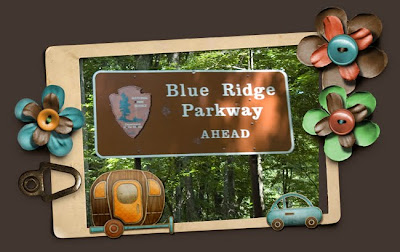
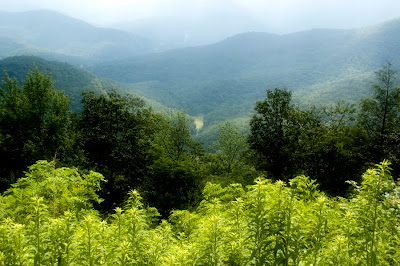

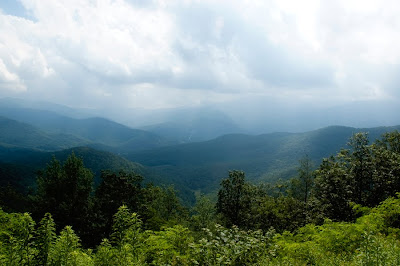
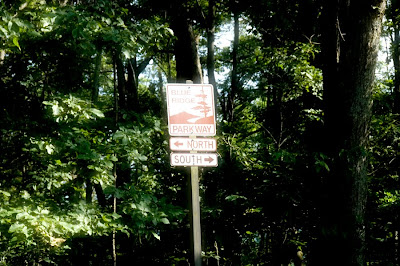
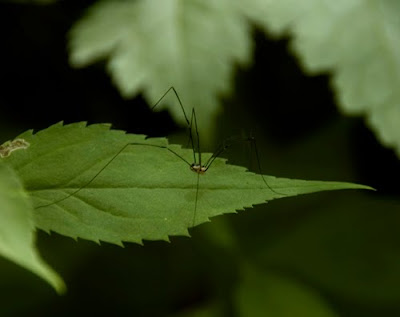
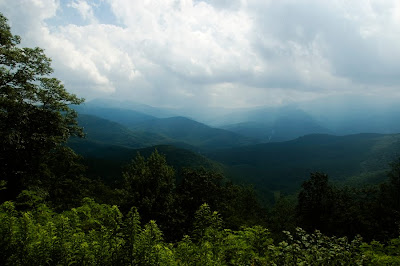 Living the life in gorgeous North Carolina!
Living the life in gorgeous North Carolina!